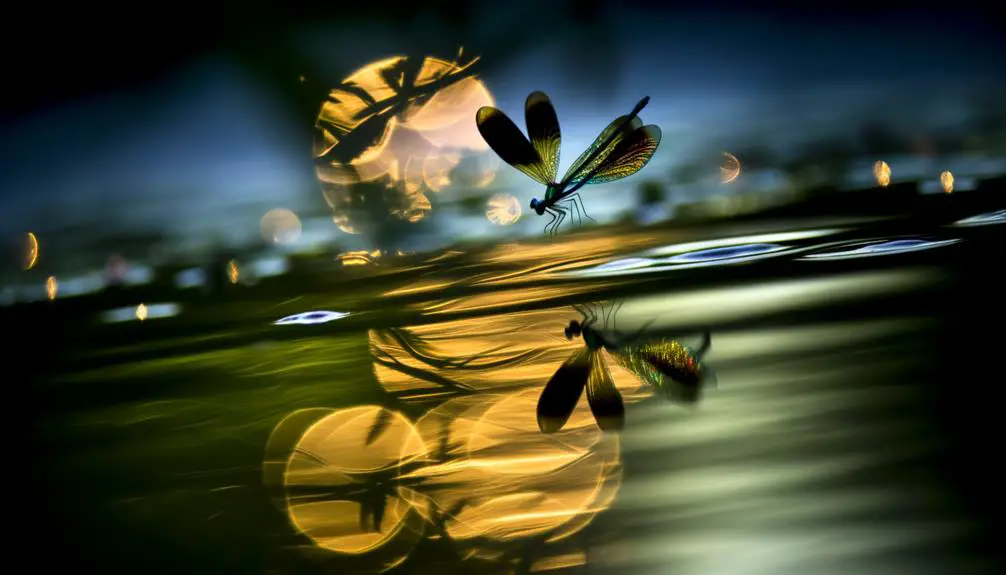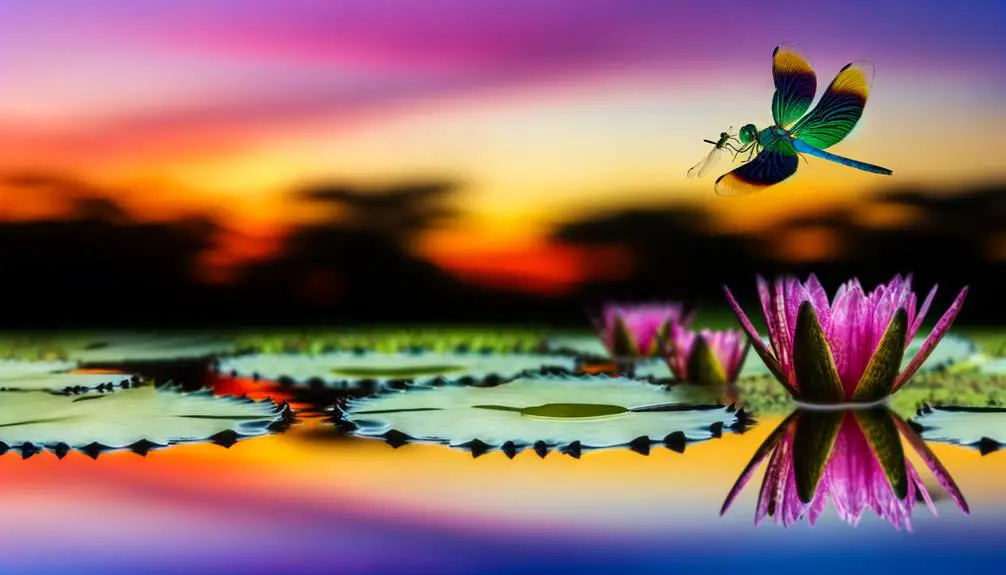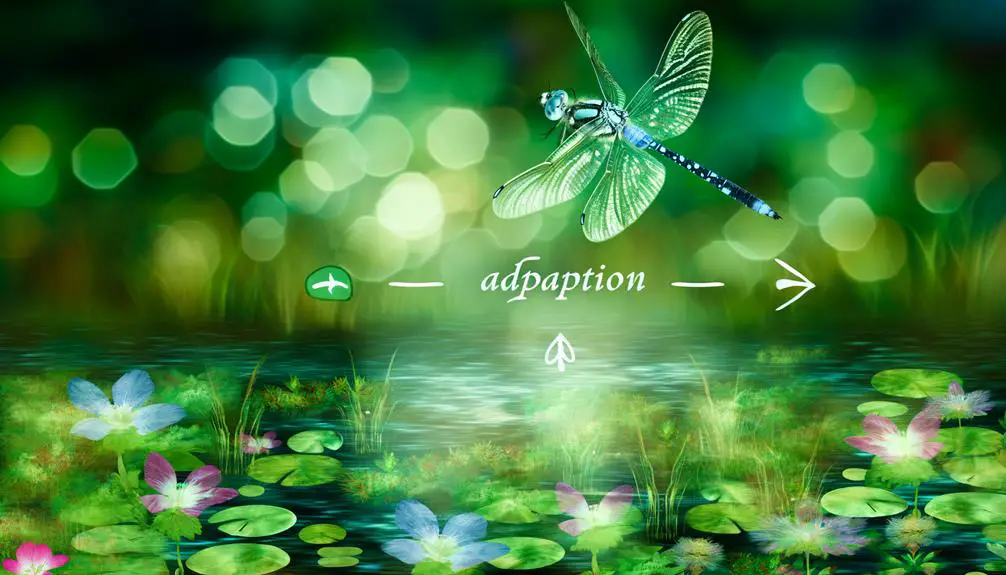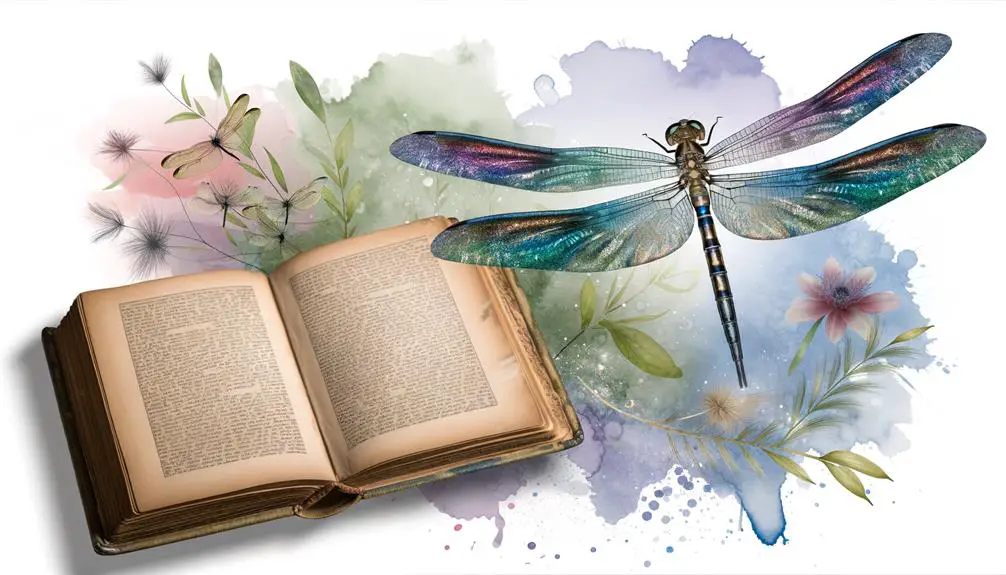Interpreting the Dragonfly Symbol for Meaning and Transformation
The dragonfly symbol embodies transformation, adaptability, and the ephemeral nature of life. Rooted in historical contexts from ancient Egypt to Indigenous tribes, it represents personal growth and spiritual awakening.
In Japanese culture, the dragonfly stands for strength, courage, and happiness, while Native American traditions view it as a messenger and sign of purity. Scandinavian folklore associates it with luck and light.
Its life cycle, which mirrors metamorphosis and resilience, enriches cultural narratives of change and adaptability. This multifaceted symbol continues to resonate deeply in various spiritual and artistic expressions, offering insights into personal and collective evolution.

Key Takeaways
- The dragonfly symbolizes transformation and adaptability, reflecting its life cycle of metamorphosis.
- In Japanese culture, it represents strength, courage, and happiness.
- Native American tribes see the dragonfly as a messenger and sign of renewal.
- The dragonfly's versatile flight patterns signify flexibility and resilience.
- It embodies spiritual awakening and self-realization across various cultures.
Historical Significance

Throughout history, the dragonfly has stood as a potent symbol across various cultures, encapsulating themes of transformation, adaptability, and the ephemeral nature of life.
In ancient civilizations, such as those in Egypt and Mesopotamia, the dragonfly often appeared in art and mythology, representing the soul's journey and the transient aspects of existence.
The insect's life cycle—from aquatic larva to aerial adult—mirrors personal growth and spiritual awakening, resonating deeply in human consciousness.
Ethnographic studies reveal that indigenous tribes, including Native American and Australian Aboriginal groups, venerated the dragonfly as a harbinger of change and a reminder of life's fleeting moments.
This historical significance underscores the dragonfly's enduring role as a universal emblem of metamorphosis and resilience.
Cultural Interpretations
Building on its historical roots, the dragonfly continues to hold multifaceted meanings in contemporary cultures, where it symbolizes not only transformation but also adaptability and spiritual insight.
In Japanese culture, the dragonfly, or 'tombo,' is seen as a symbol of strength, courage, and happiness, often featured in art and poetry.
Native American tribes, such as the Navajo, view the dragonfly as a sign of purity and a messenger between humans and the spirit world.
In Scandinavian folklore, dragonflies are believed to bring good luck and represent the power of light.
Each cultural interpretation enriches our understanding of the dragonfly, highlighting its universal appeal and profound significance across diverse societies.
Symbol of Change

The dragonfly's life cycle, which includes a dramatic metamorphosis from aquatic nymph to airborne adult, epitomizes the symbol of change, reflecting profound transformations and adaptability in various cultural narratives. This metamorphosis is not merely a biological process but is laden with symbolic meaning across different societies. In many cultures, the dragonfly is seen as an emblem of flexibility and resilience, encouraging individuals to embrace change and move forward despite life's challenges.
| Culture | Symbolism | Emotional Impact |
|---|---|---|
| Native American | Renewal and Transformation | Hope and Rebirth |
| Japanese | Courage and Strength | Inspiration and Valor |
| Celtic | Power of Light and Illusion | Mystery and Enlightenment |
These cultural interpretations underscore the dragonfly's role as a powerful icon of transformation and change.
Transformation and Growth
The dragonfly's metamorphosis from nymph to adult embodies the profound themes of transformation and growth, symbolizing the journey of embracing personal change and overcoming life's challenges.
In various cultures, this transformation is often linked to a spiritual awakening, reflecting an individual's path to enlightenment and self-realization.
Through its delicate yet resilient nature, the dragonfly inspires a deeper understanding of the interconnectedness between personal evolution and spiritual growth.
Embracing Personal Change
In many cultures, the dragonfly is revered as a powerful symbol of personal transformation and growth, reflecting its ability to adapt and thrive in diverse environments. This emblematic insect often signifies the importance of embracing change, as it undergoes a remarkable metamorphosis from aquatic nymph to aerial adult.
Ethnographic studies reveal that in Japanese culture, the dragonfly is associated with courage and renewal, embodying the spirit of perseverance. Similarly, Native American tribes view the dragonfly as a messenger of wisdom and enlightenment, urging individuals to welcome personal change.
Overcoming Life's Challenges
Drawing upon the dragonfly's symbolic metamorphosis, individuals can find inspiration to navigate and surmount the various challenges life presents, fostering profound personal transformation and growth.
In many cultures, the dragonfly's journey from nymph to agile aerial acrobat embodies resilience and adaptability. Ethnographic studies reveal that in Japanese culture, the dragonfly represents courage, strength, and happiness, serving as a metaphor for overcoming adversity.
Similarly, Native American tribes view the dragonfly as a symbol of renewal and self-realization. By internalizing these cultural significances, individuals can perceive their struggles as opportunities for metamorphosis, much like the dragonfly.
This approach encourages a mindset of resilience, transforming obstacles into catalysts for growth, ultimately leading to a more enlightened and empowered existence.
Spiritual Awakening Journey
Through the lens of various cultural narratives, the dragonfly's transformation journey symbolizes profound spiritual awakening and growth.
In Japanese culture, it is often seen as a harbinger of renewal and inner strength. Similarly, Native American tribes revere the dragonfly as a messenger of change, embodying the soul's journey towards deeper self-awareness and enlightenment.
The metamorphosis from nymph to dragonfly represents the shedding of old limitations and the embracement of new perspectives. This transformative process underscores the spiritual significance of adaptability and resilience.
The dragonfly's brief yet vibrant life serves as a poignant reminder of the impermanence of life and the importance of embracing change as a pathway to spiritual growth and enlightenment.
Adaptability in Nature

The dragonfly's adaptable nature is epitomized by its versatile flight patterns, allowing it to navigate complex environments with ease.
This adaptability is further underscored by its environmental resilience, thriving in diverse ecosystems despite changing conditions.
Additionally, the dragonfly's seasonal migrations symbolize a broader cultural understanding of the necessity for flexibility and survival in the face of nature's cycles.
Versatile Flight Patterns
In many cultures, the dragonfly's versatile flight patterns symbolize adaptability and transformation, reflecting its ability to maneuver through changing environments with ease. This adaptability is not merely a biological marvel but also a powerful metaphor in various cultural narratives.
For instance, Native American tribes view the dragonfly as a harbinger of change and self-realization, embodying the capacity for quick, agile movement through life's challenges.
Similarly, in Japanese culture, the dragonfly is a symbol of strength, courage, and happiness due to its dynamic flight.
Emotionally, consider the following:
- Hope: The dragonfly inspires belief in one's potential to overcome obstacles.
- Resilience: Its flight patterns emphasize enduring strength.
- Joy: The elegance of its maneuvers brings joy and wonder.
Environmental Resilience
Adapting seamlessly to a wide array of habitats, the dragonfly exemplifies environmental resilience, a trait that has allowed it to thrive across diverse ecological landscapes for millions of years. This adaptability is not merely biological but also cultural, symbolizing endurance and flexibility in many traditions. The dragonfly's ability to inhabit both aquatic and terrestrial environments signifies a broader narrative of survival and transformation.
| Habitat Type | Adaptation Feature | Cultural Symbolism |
|---|---|---|
| Aquatic (Larval) | Gills for underwater living | Renewal and Rebirth |
| Terrestrial | Strong flight capabilities | Freedom and Agility |
| Urban Areas | Adaptation to pollution | Resilience and Modernity |
Such versatility underscores the dragonfly's role as a beacon of resilience and adaptability in the natural world.
Seasonal Migrations
Seasonal migrations of dragonflies epitomize their extraordinary adaptability, reflecting intricate patterns of movement that resonate deeply within various cultural mythologies and ecological narratives. Dragonflies traverse vast distances, adapting to changing climates and habitats, symbolizing resilience and transformation. Their migratory journeys are emblematic of life's transient nature, often evoking profound emotional responses.
Consider the following:
- Resilience: Dragonflies navigate challenging environments, showcasing their strength and adaptability.
- Transformation: Their life cycles and migrations symbolize personal growth and change, resonating with human experiences.
- Cultural Significance: In many cultures, dragonflies are seen as messengers of change, representing the connection between life and the afterlife.
Understanding these migrations offers insights into broader ecological and existential themes, fostering a deeper appreciation for nature's complexity.
Spiritual Meanings
How do dragonflies manifest their spiritual significance across diverse cultures and belief systems?
In Japanese culture, dragonflies symbolize courage, strength, and happiness, often appearing in art and folklore.
Native American tribes, such as the Navajo, view the dragonfly as a messenger between humans and the spirit world, embodying change and transformation.
In European traditions, dragonflies are seen as harbingers of light and renewal, often linked with the souls of the departed.
The dragonfly's brief yet dynamic life cycle serves as a metaphor in many spiritual teachings, emphasizing the importance of living in the moment and embracing change.
These multifaceted interpretations underscore the dragonfly's universal resonance as a symbol of profound spiritual insight and metamorphosis.
Art and Literature

Dragonflies have long captivated artists and writers, serving as potent symbols of transformation and ephemeral beauty across various cultural narratives and artistic expressions. In art, the dragonfly often embodies the delicate balance between life and death, inspiring a sense of wonder and introspection. Literature frequently harnesses the dragonfly's fleeting existence to explore themes of transience and renewal.
- Claude Monet's Water Lilies: Monet's impressionistic renderings often feature dragonflies, symbolizing fleeting moments of natural beauty.
- Virginia Woolf's 'To the Lighthouse': Woolf uses the dragonfly to evoke fragile, transient relationships, mirroring life's impermanence.
- Japanese Haiku: Many haikus highlight the dragonfly to celebrate the ephemeral nature of life, reflecting Shinto and Buddhist sensibilities.
Through these varied depictions, dragonflies evoke profound emotional and philosophical reflections.
Dragonfly in Mythology
In numerous mythological traditions, the dragonfly emerges as a symbol imbued with profound spiritual and cultural significance, often representing transformation, adaptability, and the soul's journey.
In Japanese folklore, dragonflies are revered as symbols of courage, strength, and happiness. Native American tribes view them as messengers between humans and the spirit world, embodying change and self-realization. In Celtic mythology, the dragonfly is connected to the fairy domain and is seen as a harbinger of mystical insights.
These cultural narratives highlight the dragonfly's role in reflecting the ephemeral nature of life and the ability to navigate through transformative phases. Such ethnographic details underscore the universal appeal of the dragonfly as a symbol of profound metamorphosis and spiritual enlightenment.
Personal Symbolism

In personal symbolism, the dragonfly often represents profound transformation and change, reflecting the insect's metamorphic life cycle.
Culturally, this emblem is associated with self-realization and growth, mirroring the dragonfly's agile flight and adaptability.
Such symbolism resonates deeply within individual experiences of personal evolution and newfound understanding.
Transformation and Change
Throughout various cultures, the dragonfly is often revered as a potent symbol of transformation and change, reflecting its lifecycle from aquatic nymph to aerial adult. This metamorphosis embodies deep-rooted cultural beliefs about personal evolution and resilience.
For example, in Japanese culture, the dragonfly is seen as a harbinger of renewal and victory. Native American tribes honor it as a symbol of swiftness and activity, often linking it to change and adaptability.
The symbolic resonance of the dragonfly evokes powerful emotions:
- Hope: The promise of emerging from challenges renewed and strengthened.
- Courage: The bravery to embrace and navigate life's inevitable changes.
- Inspiration: The motivation to transcend current limitations and soar to new heights.
These interpretations underline the dragonfly's enduring significance across diverse societies.
Self-Realization and Growth
While the dragonfly's metamorphosis symbolizes transformation and change across cultures, it also serves as a profound emblem of self-realization and personal growth. Ethnographically, societies from Japan to Native American tribes regard the dragonfly as a harbinger of maturity and emotional depth. Its journey from nymph to aerial acrobat mirrors human quests for self-awareness and enlightenment.
Culturally, the dragonfly's transient lifecycle is a poignant reminder of life's fleeting nature, urging individuals to live authentically and pursue inner growth. This symbolism resonates deeply within spiritual practices, where the dragonfly encourages introspection and the shedding of illusions.
In this way, the dragonfly stands as a beacon for those seeking personal evolution, embodying the essence of self-discovery and the courage to embrace change.
Dragonfly in Dreams
Encountering a dragonfly in dreams often carries profound cultural and symbolic significance, reflecting transformation, adaptability, and a deeper connection to the subconscious. In various cultures, dreams featuring dragonflies are seen as harbingers of change and personal evolution.
Ethnographic studies highlight that such dreams can symbolize:
- Transformation: Much like the dragonfly's metamorphosis, these dreams may signify a significant personal change or spiritual awakening.
- Adaptability: The dragonfly's agility in flight can mirror one's ability to navigate life's challenges with grace and flexibility.
- Subconscious Connection: Seeing a dragonfly in a dream can prompt introspection, inviting deeper self-awareness and insight into hidden emotions.
These interpretations underscore the dragonfly's enduring cultural resonance and its role in personal symbolism.
Modern Perspectives

In contemporary contexts, the dragonfly has become a symbol of personal growth and transformation, often embraced in various forms of art, literature, and personal adornment. This insect's delicate yet dynamic nature resonates with themes of change and adaptability, inspiring modern interpretations across cultures. From tattoos to jewelry, the dragonfly symbolizes life's ephemeral beauty and the power of metamorphosis. Ethnographically, it captures the essence of fleeting moments and spiritual evolution, making it a popular motif in contemporary storytelling and media.
| Context | Representation | Significance |
|---|---|---|
| Art | Paintings, sculptures | Emphasizes beauty and transformation |
| Literature | Poetry, novels | Symbolizes change, self-realization |
| Fashion | Tattoos, jewelry | Represents personal growth and adaptability |
| Media | Films, advertisements | Highlights themes of resilience and evolution |
Conclusion
The dragonfly symbol, akin to a multifaceted gem, encapsulates historical richness, cultural interpretations, and emblematic meanings of change, transformation, and adaptability.
From ancient mythologies to modern perspectives, its significance pervades various cultures, reflecting personal and collective symbolism.
The dragonfly's presence in dreams further underscores its deep-seated role in human consciousness.
This intricate symbol, woven through the tapestry of human history, continues to evoke profound insights into the natural and spiritual domains.




